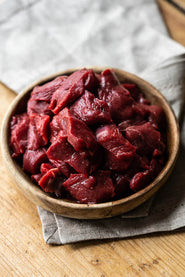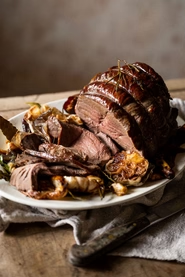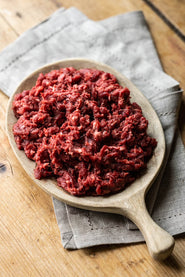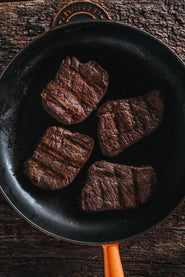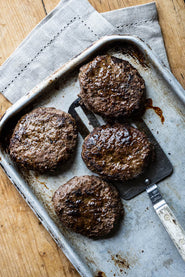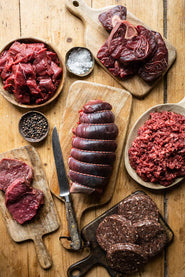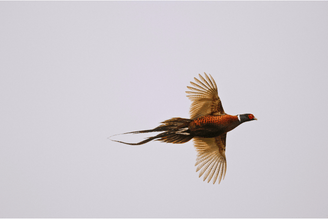When we think of red meat, our mind flits instantly to the familiarity of beef and lamb, but with its seemingly perfect balance of lean and flavourful, venison is on the rise. It’s a meat that has suffered from a bit of an identity crisis - often pigeonholed as a ‘posh’ meat, likely stemming from its history of being a food of the rich, hunted on private estates by royalty and aristocracy alike.
But the last few years has seen it popping up with increasing regularity on restaurant menus across the country as chefs are starting to favour its rich, deep taste. And with its impressive health profile – low in fat and cholesterol, yet high in protein - people are starting to recognise that this is an easy and delicious option to cook at home.
Our Venison
Just four miles from Pipers Farm, ancient parkland hosts long-established herds of red and fallow deer. The herd is made up of around 300 animals, fluctuating in number with new births in summer and culling in the autumn and winter. “Parkland venison is surely the ultimate way to rear food in the ideal setting!” Peter explains. “The herds of red and fallow deer have become established over several generations - they truly are an integral part of the landscape, and together with the wonderful property that they roam around, they create a magnificent spectacle.”
Slow-grown to natural maturity on the parkland pastures, the deer graze under the dappled shade of the ancient trees, surrounded by the deep lakes, grassy plains and rolling hills.
Their diet is made up of mother's milk, herb rich grasses and forage for their entire lives. In the autumn, they eat a lot of natural mast from the trees in the park, such as acorns and sweet chestnuts; in winter, their forage is supplemented with organic silage and fodder beet grown on the farm.
Once the deer have reached natural maturity, they are shot in the park for minimal stress. We then hang the venison carcass on the bone for 12 days to develop a wonderful depth of flavour.

Provenance
We’ve thought long and hard about the venison we sell at Pipers Farm – we only sell it from September until the beginning of spring, as that’s when we feel the meat is at its best. And not all venison is equal - understanding the issues around provenance, and the variety of flavour and texture that comes with different breeds can help to make sure your venison experience is as delicious as possible.
Wild Deer
Without natural predators, the wild deer population in this country has to be controlled or the deer would cause devastating damage to woodland and farmland alike. Culling is the process of controlling the population, and when well managed, mimics nature in the demographic of deer that are shot. Much of the hunting is done by professional ‘stalkers’ within a specific season (this season varies depending on location, sex of the animal and breed).
What impact does this have on the meat you buy? Wild venison is generally felt to have a stronger flavour and firmer texture than parkland or farmed animals, mostly due to the way the muscles develop roaming over a large area, but the impact of local forage can also factor in taste. But venison is one meat where wild isn’t necessarily best; you’re never quite sure what you’re going to get so it can be difficult to achieve consistency in the meat obtained (it is hard to precisely age a wild deer). So, while a young buck might be tender and delicious, the same not might be true of older animal. In addition, it’s important to have a reputable source, as inexpertly shot, butchered or hung meat can result in quality or safety issues.
Farmed Deer
One of the biggest motivators for farming deer is to provide a steady year-round supply to satisfy customer demand, as well as being able to closely manage the age and size of the animals that are culled.
The challenge though is one that is true across the wider farming network – there is a huge range of farms, from truly free-range enterprises to more intensive operations. As a relatively new industry, there is no formal accreditation to help consumers distinguish and only a handful of certified organic farms in the UK. In addition, a lot of the venison on sale in supermarkets is from red deer farms in New Zealand – not exactly local! Feed is also a concern, with the animal’s diet often heavily supplemented throughout the year with pellets and silage due to a lack of available forage.
Parkland Deer
Providing the deer with far more freedom and larger areas of land than their farming counterparts, these animals are still officially classified as ‘wild’. The parklands they roam are usually large private estates that closely mimic their natural habitat in terms of woodland and open ground, meaning the diet of the animals is more varied, often including nuts such as acorns in the autumn. Over winter, they may still be fed supplementary food to maintain their health and condition.
As these herds are managed, animals are closely observed to ensure their welfare, and individuals tracked so they can be culled at a specific age to provide consistency in the venison produced. For us, parkland deer provide the perfect balance of a natural habitat for the animals and a consistent product for our customers.

Breed
There are six species of deer living wild in the UK. While the lesser known species of sika, muntjac and Chinese water deer are less likely to end up on your plate, it’s important to consider how the breed affects the resulting meat - a rough rule of thumb is that the smaller the deer, the more delicate the flavour of the meat and the finer the texture.
The largest native deer in the UK, red deer, live in large herds, happy either in woodland or open moorland. Their meat is often the ‘gamiest’ in flavour (especially wild red deer), offering a dark meat with an open texture.

Fallow deer are medium in size, with white spots, with herds a common site in open land across the UK. Their meat has a finer grained texture and a mild, delicate taste making it a favourite among many venison enthusiasts. Still smaller in size are roe deer, who live alone or in small family groups and have the mildest flavour, with a soft and tender meat.

Cooking Venison
“The flavour and texture of venison is wonderful - mellow and velvety, and exceptionally well suited to a sauce made with robust red wine and damson, or port & plum!” Peter explains. It’s an incredible versatile meat; from slow stews and comforting casseroles to succulent steaks and lean burgers. For chops, fillet and saddle, cook the meat fast and leave to rest. For the shoulder and breast meat, you need a little patience, as this must be cooked low and slow to get the best results. For a joint or a steak, it is best cooked rare to make the most of its fine-grained texture and succulent, light, gamey taste.
Want to give it a try? See our range of Venison


